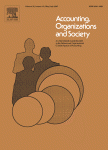Transnational regulation of professional services: Governance dynamics of field level organizational change
- a Department of Strategic Management and Organization, 3-23 Business Building, Alberta School of Business, University of Alberta, Edmonton, AB, Canada T6G 2R6
- b Department of Accounting and Management Information Systems, 3-23 Business Building, Alberta School of Business, University of Alberta, Edmonton, AB, Canada T6G 2R6
- Available online 10 October 2006
Introduction
Methods and objectives
Shifting governance: from local monopoly to global cartel
Erosion of professional governance
The emergence of a new field: transnational professional services
Discussion and theoretical implications
Conclusion
Acknowledgements
References
Abstract
This paper examines the role of large accounting firms in the emergence of a transnational regulatory field in professional services. We use neo-institutional theory to illuminate the process by which new fields are created. We observe a shift in the structural boundaries of professional regulation to include new actors, specifically Big Four accounting firms and non-governmental organizations. We also observe a shift in regulatory logics in which historical efforts to separate professional practice from commercial interest are embraced rather than suppressed. New logics also include pressures to adopt new occupational identities. Finally we describe a shift in institutional power structures from coercive structures of domination to inclusive power structures of membership and identity.
Figures and tables from this article:
Table 1. Growth in scale of Big Eight (Five): 1980–2000

- View Within Article
Table 2. Global expansion of Big Eight (Five): 1982–1995 12-year change in total number of offices and partners

Source: Centre for International Financial and Accounting Research, 1994, Princeton: CIFAR publishing, p. 283.
- View Within Article
Table 3. Global Market for Audit Services, 1975, 1988 and 1995

- View Within Article
Table 4A. Revenue split (%) for individual US Big Six (Five) firms: 1975–1999

- View Within Article
Table 4B. Proportional US revenue sources for Big Eight (Five) firms: 1975, 1990 and 1999

Sources: Public Accounting Report, various years and Fortune.
- View Within Article







